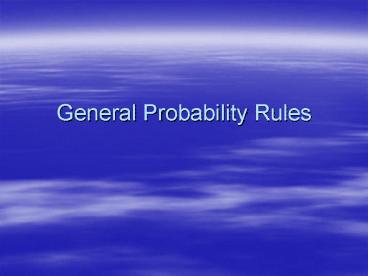General Probability Rules
1 / 21
Title:
General Probability Rules
Description:
E=event customer has auto insurance. F=event customer has homeowners. Example: ... Now, let's calculate P(E), the probability that an extended warranty is purchased. ... –
Number of Views:47
Avg rating:3.0/5.0
Title: General Probability Rules
1
General Probability Rules
2
Review
- Probability of when E and F are disjoint is
easy - If E and F are independent then we can compute
3
General Addition Rule for Two Events
- For any two events E and F,
4
General Multiplication Rule for Two Events
- For any two events E and F,
5
Example
- 60 of customers of an insurance agency have
automobile policies, 40 have homeowners and 25
have both. What is the probability that he or
she has at least one of these two types? (Note a
customer may have only a life insurance policy.) - Let
- Eevent customer has auto insurance
- Fevent customer has homeowners
6
Example
- P(customer has at least one of the two types of
policy)
7
Example
- P(customer has exactly one of the two types of
policy) - (Mr. Nollen Draws Venn Diagram)
8
Example
- Suppose 20 of teenage drivers received a
citation for a moving violation in the past year.
Of those 80 went to driving school so the
citation would not appear on their record. If a
teenage driver is randomly selected, what is the
probability that he or she received a citation
and attended traffic school?
9
Example (cont)
- LetFselected driver received a
citationEselected driver attended traffic
school - What are we looking for?
- What do we know?
10
Example (cont)
- What can we use to find
- Multiplication rule
11
Example II
- The table gives information on VCRs sold by an
appliance store - What is the probability that the selected
customer purchased a brand 1 model and an
extended warranty?
12
Example II (cont)
- Lets define the following events
- B1 event that brand 1 is purchased
- B2 event that brand 2 is purchased
- E Event that an extended warranty is purchased
- What is
13
Example II (cont)
- Lets define the following events
- B1 event that brand 1 is purchased
- B2 event that brand 2 is purchased
- E Event that an extended warranty is purchased
- Find (Do it now)
14
Example II (cont)
- Now, lets calculate P(E), the probability that
an extended warranty is purchased. - This can happen two different ways buy brand 1
and warranty or buy brand 2 and warranty. - Furthermore, since each customer purchased a
single VCR, they could not have purchased both
brand 1 and brand 2, so the two events are
disjoint.
15
Example II (cont)
- Finding P(E) (that an extended warranty is
purchased.
16
The Law of Total Probability
- IF B1 and B2 are disjoint events with
- P(B1)P(B2)1, then for any event E
17
The Law of Total Probability
- More generically
- IF B1, B2, BK are disjoint events with
- P(B1)P(B2)P(BK)1
- then for any event E
18
Last Example
- 68 of elementary school students from Beachwood
said that they always wear a helmet when
bicycling, but only 23 of students from Morland
wear a Helmet. - B selected student from Beachwood
- M selected student from Morland
- H select student always wears a helmet
- P(B) P(M) .5
19
Last Example
- What portion of students always wears helmets?
(Do it now.) - B selected student from Beachwood
- M selected student from Morland
- H select student always wears a helmet
- P(B) P(M) .5
- 44.5 of the school children in these two
communities always wear a helmet
20
Practice
- DO 6.60 Now!
- Start by defining two events and then stop!
- Now, using those events, show everything the
problem asserts. - What is question (a) asking?
- Do it (a) now!
- What is part (b) asking?
- Do (b) now.
- What is question (c) asking?
- Do (c) now.
- Do (d) now.
21
Homework
- 6.53-6.63 odd































